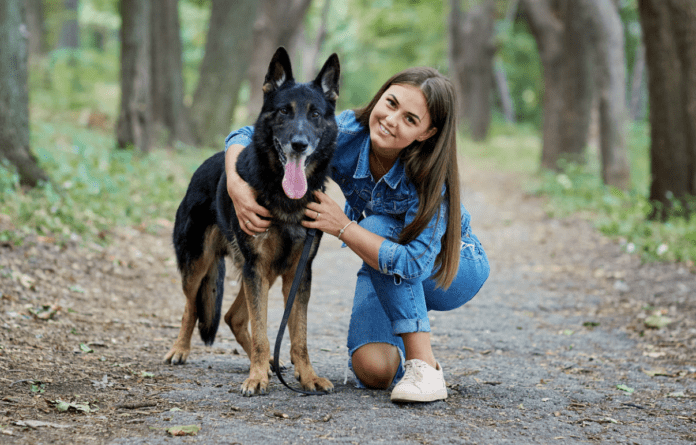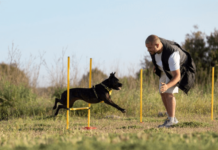Last Updated on August 19, 2023 by Dogs Vets
How To Train a German Shepherd
The German Shepherd is such a graceful and loyal dog that it exudes nothing short of canine excellence. Esteemed for its superior intelligence and work ethic, this dog breed stops at nothing to please its human companion.
The radiance of an adequately trained German Shepherd is an experience to behold.
However, harnessing the full potential of this dog breed requires a great deal of consistent training and engagement.
Starting early is essential, as the formative years are periods when you can really shape your dog to fit your lifestyle. It takes some work, but the fruits make the effort worthwhile.
So, here’s how to train a German Shepherd without stress. Let’s dive in!
Understanding The German Shepherd Breed
To adequately train a German Shepherd (GSD), it is imperative to understand the breed’s history and unique characteristics.
Their intelligence plus an unyielding desire to learn and work make them one of the most trainable dog breeds. Historically, this has made them a cherished choice when it comes to herding, search and rescue, and other police work.

Speaking of herding, German Shepherds were developed in the late 1800s, originally because of their high alertness and ability to be shepherds.
Their heritage as service dogs makes them excel even in police work, as was seen during World War I and II. This breed’s ability to learn and take command, plus exceptional problem-solving skills, made them a top military choice.
Furthermore, their loyalty and ability to be family pets made them popular for the rest of the 20th century.
German Shepherds also perform quite well as family pets. They bond with their owners; therefore, they can be protective to a fault. Their loyalty and devotion to their family make them one of the most popular dogs globally today.
However, they can be quite stubborn and, if not well managed, can develop serious behavioral issues. This is why they require a lot of training and socialization.
How to Train a German Shepherd
Establish Bond and Socialize Early (2 months to 3 months)
- Commit to establishing trust. This involves building a strong bond with your pet, which is the foundation for effective training. It’s simple. Spend quality time with your dog and engage in playful activities to foster mutual understanding.
- House training and basic commands. Housetraining is important because you won’t always be there to monitor your dog. So, it’s important to crate and potty train them so they don’t relieve themselves in the wrong places. Also, teaching them basic commands like “sit,” “stand,” and “go to bed” will come in handy.
- Introduce your pet to the outside world. Take your GSD out often so they can get familiar with various environments, people, and pets. While this is necessary for an overprotective dog, you should take it easy on them at this young age.
- Leash training. While you’re at it, also introduce your GSD to leash manners. This is to help you control them for the safety of others. Also, be careful that the stress on the dog’s neck is not too much.
Obedience Training (Three months to nine months)
- Recall training. Giving your dog a name is a no-brainer, especially before obedience training. A name is a unique identifier that helps it respond to your call immediately. Therefore, recall training teaches your dog to come to you when called.
- Impulse control. When dogs get bored, they begin to exhibit undesirable behaviors like an aggressive rush towards food, unnecessary barking, digging, etc. The key to stopping this is to get your dog busy and teach discipline. Provide a toy, allow the dog to go outside to play, or rub its head gently.
- Positive reinforcement. Rewarding good behavior with treats, for example, helps you achieve a lot of progress in no time. Praising your dog for following commands encourages your pet to keep at it. Correct bad behavior immediately, but avoid screaming or other aggressive means.
Advanced Training (Nine months to adulthood)
- Engage more often. GSDs are quite an energetic breed with a strong work ethic; therefore, keeping them engaged and mentally active is imperative. Also, given that this is when they transition to adulthood and become more independent, you need to show leadership and continue obedience training for your pet.
- Polish problem-solving skills. As you continue to work on impulse control and obedience, you may also introduce them to more task-based activities. Outdoor activities like agility training, herding, tracking scents, etc.
5 Basic Commands to Teach Your German Shepherd
- Name recognition and recall. As mentioned earlier, this is one of the foundations for effective communication with your pet. Give your pet a name, and train it to come to you when you call out that name.
- “Sit” or “Down”. GSDs can be quite playful, so a simple way to call them to order is to tell them to sit. You can teach your pet to obey this command by holding a treat to its nose and moving your hand down to the ground. Repeat and reward until mastery.
- “Let’s go”. This is to tell your dog to walk by your side, especially without a leash. Hold a treat on the side you want your dog to go to and keep repeating the command until understood. Practice this during walks, and it will save you a lot of stress in public.
- “Leave it”. Without shouting but in a stern tone, tell your GSD to “Leave it” to, first, get their attention and, second, get them to obey. This is especially helpful when they’re playing with harmful objects or about to break something. Try not to shout.
- “Quiet”. The “Quiet” command is to stop excessive barking or other noise. For several reasons, from agitation to boredom to excitement, German Shepherds can get noisy. So use the command to get some silence. Remember to reward obedience.
Conclusion: Tips on Training a German Shepherd
Training a German Shepherd into a confident, happy, and well-behaved companion holds numerous benefits. However, to fully unlock the potential of this exceptional breed, one needs to:
- Establish bond early
- Socialize the pet early
- Show leadership
- Consistently engage the pet
- Praise and reward upon obedience
- Refrain from shouting or hitting the pet
- Be responsive.
Fact Check
We strive to provide the latest valuable information for pet lovers with accuracy and fairness. If you would like to add to this post or advertise with us, don’t hesitate reach us. If you see something that doesn’t look right, contact us!

















